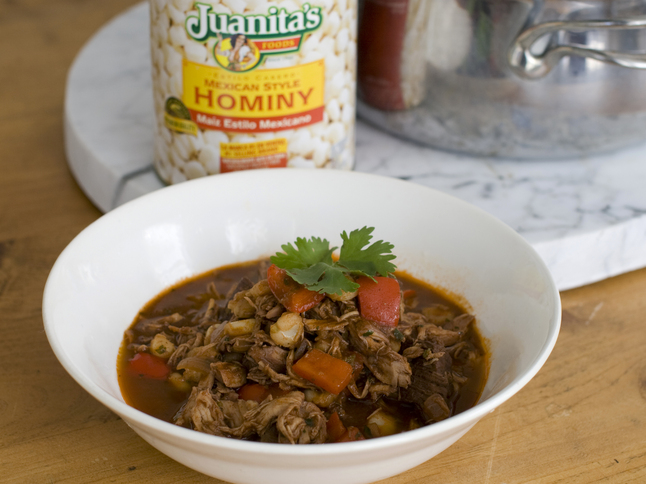Hominy: What it is and how to use it

Hominy lends a fresh, tender corn flavor to a rich stew of pulled chicken and seared steak tips as shown in Concord, N.H.
AP Photo |Matthew Mead
Hominy is one of those foods you might think you've never tried, yet almost certainly have. Or at least a close relative of it.
That's because the ingredient that starts as hominy can end as many different dishes across many cultures, from Mexican pozole to Southern grits to the corn nuts down at your neighborhood bar.
But first, the basics.
Hominy is the name given to whole corn kernels, usually white, that have been cooked in a lye or lime solution to remove their thick hulls. The result is a tender, somewhat bulbous kernel with a chewy texture and a clean, corn flavor.
In Latin America, these kernels are used most often in soups and stews, such as pozole, a highly seasoned stew of hominy, pork and chili peppers.
The Southern staple known as grits follows a similar path. In this case, the hominy is dried after processing, then coarsely ground. The resulting meal then is cooked with water or milk to a porridge-like consistency similar to polenta.
Finally, there is the snack food — corn nuts. These are produced much like hominy, except the kernels are soaked in water after the hulls are removed. They then are dried and fried until crunchy, then seasoned and consumed alongside intoxicating beverages.
Cans of basic hominy are widely available at most grocers, either among the canned vegetables or in the Hispanic foods aisle. For ideas for using hominy, check out the Off the Beaten Aisle column over on Food Network: http://bit.ly/Q4plGV
___
PULLED CHICKEN AND HOMINY STEW
Start to finish: 45 minutes
Servings: 8
1 tablespoon olive oil
1 large yellow onion, diced
4 cloves garlic, minced
1 teaspoon ground cumin
1 teaspoon cinnamon
1 teaspoon cayenne pepper
1 teaspoon smoked paprika
1 teaspoon mustard powder
1 pound steak tips, cut into 1-inch chunks
1 quart beef broth
2 cups red wine
6-ounce can tomato paste
Juice of 2 limes, divided
1 tablespoon Worcestershire sauce
2 pounds boneless, skinless chicken breasts, cut into large chunks
2 red bell peppers, cored and chopped
29-ounce can hominy, drained
1/4 cup packed brown sugar
Salt and ground black pepper
1/4 cup chopped fresh cilantro
In a large saucepan over medium-high, heat the oil. Add the onion, garlic, cumin, cinnamon, cayenne, paprika and mustard powder. Saute until the onions are tender, about 4 minutes. Add the steak tips and sear, turning to brown, about 3 minutes.
Add the broth, wine, tomato paste, juice of 1 lime, and Worcestershire sauce. Bring to a simmer. Add the chicken, then cook for 15 to 20 minutes.
Use a slotted spoon to transfer the chicken to a cutting board. Use 2 forks to shred the chicken, then return it to the pot.
Add the bell peppers, hominy and brown sugar. Simmer, uncovered, for 5 to 6 minutes. Season with salt and pepper, then stir in the juice of the remaining lime and the cilantro.
Nutrition information per serving (values are rounded to the nearest whole number): 430 calories; 90 calories from fat (21 percent of total calories); 10 g fat (2.5 g saturated; 0 g trans fats); 110 mg cholesterol; 35 g carbohydrate; 43 g protein; 5 g fiber; 1,270 mg sodium.
___
J.M. Hirsch is the national food editor for The Associated Press. Follow him on Twitter at http://twitter.com/JM_Hirsch.


Comments
Tony Livingston
Sun, Sep 9, 2012 : 2:36 p.m.
I noticed you say it may be cooked in a lye solution. How does that affect the corn? Is it safe?
Tru2Blu76
Sun, Sep 9, 2012 : 3:14 p.m.
Minor correction: hominy isn't cooked in a lye solution, the lye-soaking part of the process comes before the final food product. Apparently, hominy was originally made by native Americans (the Cherokee tribe, creators of the only Native American alphabet are mentioned). So we can conclude that the process includes complete removal of any caustic / alkaline chemicals. So yeah, the final food product is perfectly safe to eat. Oh, and the lye-soaking is apparently done to kill the the corn seed's germ and prevent sprouting in storage. It just happens to also produce a new form of corn-based food as a result.
J. A. Pieper
Sun, Sep 9, 2012 : 2:23 p.m.
I have always hated hominy and grits, and during travels through the South as a child it frequently found its way to a breakfast or dinner plate. BUT, I have heard that it is great in chili or stews, so it is worth trying again. This recipe sounds interesting!